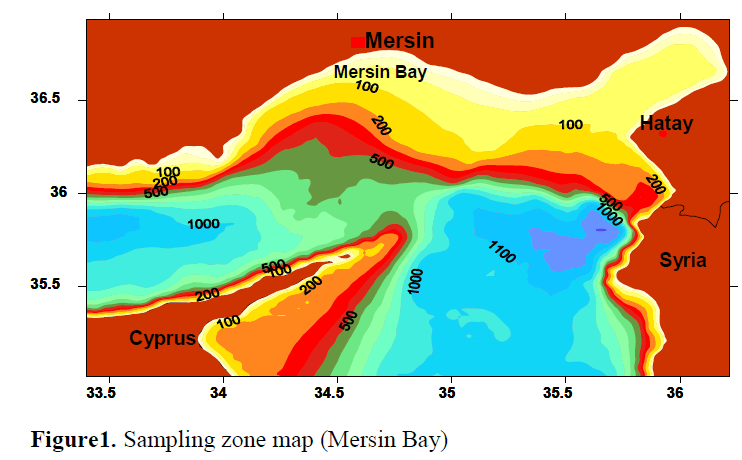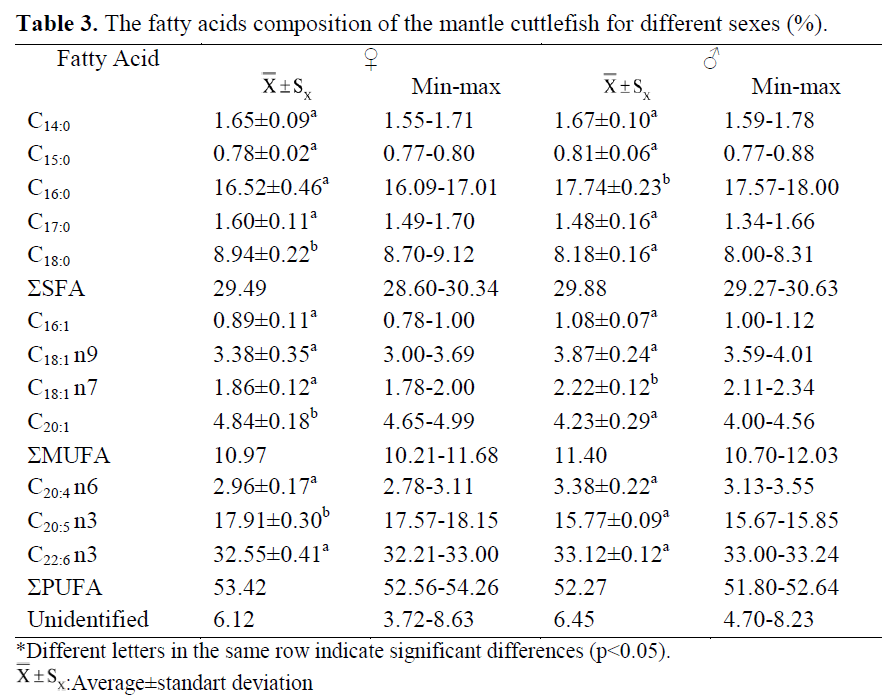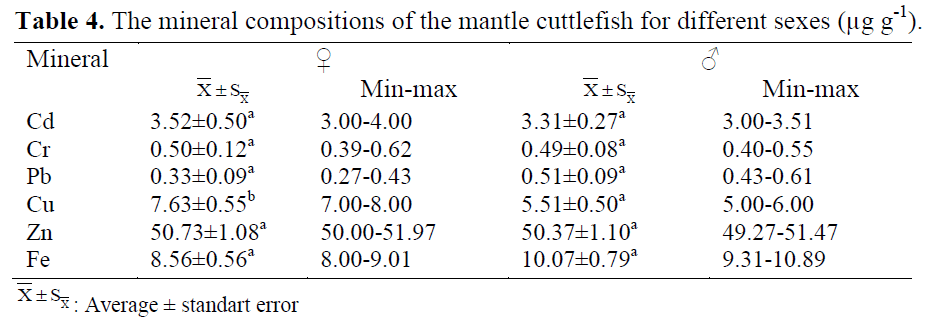Keywords
Sepia officinalis, Chemical Composition, Meat Yield
Anahtar Kelimeler
Sepia officinalis, Kimyasal Kompozisyon, Et verimi
Introduction
Cuttlefish is an important species of marine invertebrates consumed both in the world and our country. According to Fisheries Statistics (2008) report, 1.288 and 1.502 tons of cuttlefish were caught in 2007 and 2008, respectively in Turkey. According to Fisheries Report (2010), 17 and 77 tons of cuttlefish were caught in 2008 and 2009, respectively in Turkey. Meat yield of cuttlefish has been reported to change due to sexual differ-ences (Erdilal et al., 2007). While cuttlefish con-tain low levels of lipid, it is rich for protein level (Reale et al. 2006, Ozogul et al. 2008). Lipids of cuttlefish contain high levels of long-chain n-3 polyunsaturated fatty acids. The dominant long-chain n-3 fatty acids of cuttlefish are EPA and DHA (Thanonkaew et al. 2006, Ozyurt et al. 2006, Zlatanos et al. 2006). These fatty acids are of great importance to humans for the prevention of coronary heart disease (Tavani et al. 2001). Mantle of cuttlefish was rich in terms of Cu, Zn, Fe (Miramand and Bently, 1992, Raimundo et al. 2005, Miramand et al. 2006, Laourenço et al. 2009, Pereira et al. 2009). In this study, chemical composition and meat yield of mantle of adult female and male cuttlefish (Sepia officinalis) were investigated.
Materials and Methods
Materials
The common cuttlefish is generally caught in the Mediterranean and Aegean Seas in Turkey. This species used in this study was caught in Mersin Bay with net in spring season in 2008 (Figure 1). In the fishing procedure, dip net which had mesh size of 32 mm was used. 20 male and 20 female individuals of this species were caught and kept in polystyrene boxes with ice.

Figure 1. Sampling zone map (Mersin Bay)
Sample preparation
Some morphometric measurements [mantle length (ML) and total length (TL)] of all samples (male and female) were carried out with a ruler (Table 1). Mantle which is the main edible por-tion of cuttlefish was homogenized and chemical analyses were done on this part of fresh samples.

Table 1. Some morphological measurements and meat yield of cuttlefish for different sexes.
Proximate analysis
The mantle cuttlefish samples were analyzed in triplicate for the proximate composition. The following methods were used for proximate anal-ysis: Lipid content by the Bligh and Dyer (1959) method, water content by AOAC (1998a) method, total crude protein by the Kjeldahl method (AOAC, 1998a) and total mineral sub-stance (TMS) content by the AOAC (1998b) method.
Fatty acid analysis
Fatty acid profiles of fat extracted from the cuttlefish samples were determined by gas chro-matography (GC) of methyl esters. Methyl esters were prepared by transmethylation using 2 M KOH in methanol and n-heptane according to the method decribed by Ichibara et al. (1996) with minor modification. Extracted lipids (10 mg) were dissolved in 2 mL n-heptane followed by 4 mL of 2 M methanolic KOH. The tube was then vortexed for 2 min at room temperature. After centrifugation at 4,000 rpm for 10 min, the hep-tane layer was taken for GC analyses.
The fatty acid composition was analyzed by the GC Clarus 500 with autosampler (Perkin Elmer, Shelton, CT, USA) equipped with a flame ionization detector and a fused silica capillary SGE column (30 m 0.32 mm, ID 0.25 mm, BP20 0.25 UM; SGE Analitic Science Pty Ltd, Victo-ria, Australia). The oven temperature was 140 °C, held for 5 min, raised to 200 °C at a rate of 4 °C/min and to 220 °C at a rate of 1 °C/min, while the injector and the detector temperature were set at 220 °C and 280 °C, respectively. The sample size was 1 μL and the carrier gas was controlled at 16 ps. The split used was 1:50. Fatty acids were identified by comparing the retention times of fatty acid methyl esters with a standard 37-component fatty acid methyl ester mixture (cata-log no 18919; Supelco). Triplicate GC analyses were performed and the results were expressed in GC area % as the mean value±standard deviation.
Mineral analysis
The mantle tissue samples used for mineral analysis were dried at 105°C to reach constant weights, and then concentrated nitric acid and percholoric acid (2:1 v/v) were added to the sam-ples, and they were put on a hot plate set to 150°C until all tissues were dissolved. All mantle tissue samples were analyzed with ICP-AES. The analyses were performed at least in triplicate.
Statistical analysis
Statistical analysis of data was carried out with the SPSS 16.0. T-test was used to evaluate the effects of sex on the chemical compositions of cuttlefish.
Results and Discussion
Meat yield
Table 1 shows some morphological measure-ments and meat yield of adult male and female cuttlefish. In this study, average mantle lengths of female and male cuttlefish were 140 mm and 163 mm, respectively (Table 1). In a study carried out by Erdilal et al. (2007) in Antalya Bay, males with the mantle length over 87 mm and females with the mantle length over 100 mm were ac-cepted as adults. Thus, according to the results of this study, male and female cuttlefish used in our study were adults.
In this study, while meat yield was found to be almost 30.18% for females, it was 35.23% for males (Table 1). Erdilal et al. (2007) reported meat yield as % 30.64 for females and as 35.20 for males.
Proximate compositions
Table 2 gives the proximate compositions of mantle of female and male cuttlefish. Statisti-cally, there were not variations in protein, lipid, water and TMS content of mantle tissues of both adult females and males (p>0.05).
The levels of protein ranged from 22.15% to 22.20%, lipid from 0.86% to 1.01%, and water from 74.97% to 75.30%, total mineral substance (TMS) from 1.68% to 1.69% for the mantle of cuttlefish (Table 2). Reale et al. (2006) reported that protein, lipid, water and TMS contents were 18.32%, 2.38%, 78.68% and 1.51% for mantle of cuttlefish, respectively. In a similar study, Ozogul et al. (2008) also reported the contents of protein, lipid, water and TMS as 16.91%, 1.01%, 81.02%, 1.12%, respectively. The current study also showed that mantle of cuttlefish caught from the Gulf of Mersin had high protein (22.20% for fe-male and 22.15% for male) and low fat contents (0.86% for female and 1.01% for male).

Table 2. The proximate compositions of the mantle cuttlefish for different sexes (%).
Fatty acids profiles
Fatty acids (SFAs, MUFAs, PUFAs) in S. of-ficinalis are presented in Table 3. In the present study, the major fatty acids found in S. officinalis were palmitic acid (C16:0), stearic acid (C18:0), eicosapentaenoic acid (EPA, 20:5n3) and do-cosahexaenoic acid (DHA, 22:6n3). These results correspond to previous studies on fatty acids of cuttlefish (Hayashi and Bower 2004, Ozyurt et al., 2006; Reale et al., 2006; Zlatanos et al., 2006; Ozogul et al., 2008).

Table 3. The fatty acids composition of the mantle cuttlefish for different sexes (%).
The levels of saturated fatty acids (SFA) ranged from 29.49% to 29.88%, monounsatu-rated fatty acids (MUFAs) from 10.97% to 11.40%, and polyunsaturated fatty acids (PUFAs) from 52.27% to 53.42% for cuttlefish. Ozyurt et al. (2006) reported that SFA, MUFAs and PUFAs levels were 29.5-36.8%, 7.8-9.8%, 43.7-49.6% for mantle of cuttlefish, respectively. In a similar study, Ozogul et al. (2008) also reported the contents of SFA, MUFAs and PUFAs as 29.8-31.3%, 6.9-8.3%, 53.1-56.3%, respectively. Thanonkaew et al. (2006) reported that SFA, MUFAs and PUFAs levels were 35.1%, 11%, 50.3% for mantle of cuttlefish, respectively.
The dominant SFAs were palmitic acid (16.52%-17.74%), and stearic acid (8.18%-8.94%) for both of the sexes. The highest total SFA levels were found in the mantle of male cut-tlefish. Statistically, there were significant differ-ences in palmitic acid and stearic acid levels in mantle tissue of male and female cuttlefish (p<0.05). Zlatanos et al. (2006) reported that the amount of palmitic acid and stearic acid contents in cuttlefish 23.3% and 8.5%, respectively. Ozyurt et al. (2006) reported that palmitic acid and stearic acid levels were 17.0-21.0%, 7.5-8.8% for mantle of cuttlefish, respectively. In a similar study, Ozogul et al. (2008) also reported the contents of palmitic acid and stearic acid as 17.6-19.0%, 7.9-8.2%, respectively.
The total MUFA percentage was the highest in mantle of male cuttlefish. Significant differ-ences were not observed in terms of oleic acid between females and males (P>0.05). Statisti-cally, there were significant differences in cis-11 eicosenoic acid levels (C20:1) in mantle tissue of male and female cuttlefish (p<0.05). Cis-11 ei-cosenoic acid (C20:1, 4.23-4.84%) was the major MUFA in all samples, followed by oleic acid (C18:1 n-9, 3.38-3.87%). Ozogul et al. (2008) reported that the amounts of cis-11 eicosenoic acid (C20:1) and oleic acid (C18:1 n-9) contents in cuttlefish 3.71% and 3.48%, respectively.
Lipids of cuttlefish contain high levels of long-chain n-3 polyunsaturated fatty acids (nearly 50-52%). The total PUFA value in mantle of fe-male was higher than that of the male. DHA (32.55-33.12%) was the major PUFA in all sam-ples, followed by EPA (15.77-17.91%). The dominant long-chain n-3 fatty acids of cuttlefish are EPA and DHA (Thanonkaew et al. 2006, Ozyurt et al. 2006, Zlatanos et al. 2006). Statisti-cally, there were no significant differences in DHA levels in mantle tissue of male and female cuttlefish (p>0.05). Besides, EPA levels in man-tle of female cuttlefish were higher than those of the male (p<0.05).
Mineral contents
Mineral contents of mantle tissue of female and male cuttlefish are presented in Table 4. It was found that this species was rich in terms of mineral content, especially Cu, Zn, and Fe.

Table 4. The mineral compositions of the mantle cuttlefish for different sexes (µg g-1).
Cd, Cr, Pb, Zn and Fe levels in mantle tissue of female and male cuttlefish were not signifi-cantly different (p>0.05). Cu contents of female mantle tissue were significantly higher (p<0.05) than those found in male mantle tissue. In this study, mineral levels of mantle tissue of cuttlefish were 3.31-3.52 μg Cd g-1, 0.49-0.50 μg Cr g-1, 0.33-0.51 μg Pb g-1, 5.51-7.63 μg Cu g-1, 50.37-50.73 μg Zn g-1, 8.56-10.07 μg Fe g-1, respec-tively. Raimundo et al. (2005) found out that Zn, Fe, Cu, and Cd levels of mantle tissue of cuttle-fish were 79-88 μg g-1, 10-12μg g-1, 8.6-12μg g-1, 0.03-0.16 μg g-1, respectively. In present study, Cd levels were found to be higher than those found by other researchers. This was could be the differences in Cd contamination in catching ar-eas. In a similar study, Lourenço et al. (2009) found out that mineral levels of mantle tissue of cuttlefish were 4.50 μg Cu g-1, 1.40 μg Fe g-1, 17.70 μg Zn g-1, 0.31 μg Cd g-1, 0.04 μg Pb g-1, respectively. These values were lower than those obtained in this study. This difference might have been caused by the regional differences, sexual maturation and size of individuals.
Conclusion
The Official Journal of European Commission (2001) sets food contamination levels for mantle tissue of cephalopods as 1 μg Cd g-1, 1 μg Pb g-1. For Turkish Food Codex (2005), these levels are presented as 1 μg Cd g-1, 1 μg Pb g-1, 20 μg Cu g-1 and 50 μg Zn g-1. However, the present study reveals that Cd and Zn levels are higher than those given above. Although high levels of these minerals do not directly affect human health, the excess cadmium and zinc could be accumulated in the food chain and by being carried to the up-per trophic levels, they might create important ecological problems.
655
References
- AOAC. (1998a). Official method 955.04. Nitro-gen (total) in seafood. Fish and other marine products. In: Hungerford JM, chapter editor; Cunniff P, editor. Official methods of analy-sis of AOAC International, Chapter 35, p. 6. Arlington, WA
- nAOAC. (1998b). Official method 938.08. Ash of seafood. Fish and other marine products. In: Hungerford JM, chapter editor; Cunniff P, editor. Official methods of analysis ofAOAC International, Chapter 35, p. 6. Gaithersburg, Maryland
- nBligh, E.G., Dyer, W.J., (1959). A rapid method of total lipid extraction and purification, Bi-ochemistry and Cell Biology, 37(8): 911-917. doi: 10.1139/o59-099
- nErdilal, R., Ünlüsayin, M., Gülyavuz, H., (2007). Mürekkep Baligi (Sepia officinalis L., 1758)’nda eseysel olgunluk safhalarina göre et verimi ve su oraninda olusan degisimler, Ege Üniversitesi Su Ürünleri Dergisi, 24(3-4): 247-251
- nFisheries Statistics, (2008). State Institute of Sta-tistics Prime Ministry Republic of Turkey, p.2-4, Ankara
- nHayashi, K., Bower, J. R., (2004). Lipid compo-sition of digestive gland, mantle and stom-ach fluid of the gonatid squid Berryteuthis anonychus, Journal of Oleo Science, 53(1): 1-8. doi: 10.5650/jos.53.1
- nIchibara, K., Shibahara, A., Yamamoto, K., Na-kayama, T., (1996). An improved method for rapid analysis of the fatty acids of glyc-erolipids, Lipids, 31: 535-539. doi: 10.1007/BF02522648
- nLourenço, H.M., Anacleto, P., Afonso, C., Fer-raria, V., Martins, M.F., Carvalho, M.L., Lino, A.R., Nunes, M.L., (2009). Elemental composition of cephalopods from Portu-guese continental waters, Food Chemistry, 113: 1146- 1153. doi: 10.1016/j.foodchem.2008.09.003
- nMiramand, P., Bentley, D., (1992). Concentration and distribution of heavy metals in tissues of two cephalopods, Eledone cirrhosa and Se-pia officinalis, from the French coast of the English Channel, Marine Biology, 114: 407-414. doi: 10.1007/BF00350031
- nMiramand, P., Bustamante, P., Bentley, D., Kou-eta, N., (2006). Variation of heavy metal concentrations (Ag, Cd, Co, Cu, Fe, Pb, V and Zn) during the life cycle of the common cuttlefish Sepia officinalis, Science of the Total Environment, 361: 132-143. doi: 10.1016/j.scitotenv.2005.10.018
- nOfficial Journal of the European Communities, (2001). Official Journal of the EuropeanCommunities, Commision Regulation No: 466, Maximum Levels for Certain Contami-nants in Foodstuffs, s:7-11
- nOzogul, Y. Duysak, O., Ozogul, F., Ozkutuk, A.S., Tureli, C., (2008). Seasonal effects in the nutritional quality of the body structural tissue of cephalopods, Food Chemistry, 108: 847-852. doi: 10.1016/j.foodchem.2007.11.048
- nOzyurt G., Duysak, O., Akamca, A., Tureli C., (2006). Seasonal changes of fatty acids of cuttlefish Sepia officinalis L. (Mollusca: Cephalopoda) in the north eastern Mediter-ranean sea, Food Chemistry, 95(3): 382-385. doi: 10.1016/j.foodchem.2004.12.044
- nPereira, P., Raimundo, J., Vale, C., Kadar, E., (2009). Metal concentrations in digestive gland and mantle of Sepia officinalis from two coastal lagoons of Portugal, Science of the Total Environment, 407: 1080-1088 (2009).ndoi: 10.1016/j.scitotenv.2008.10.023
- nRaimundo, J., Pereira, P., Vale, C., Caetano, M., (2005). Fe, Zn, Cu and Cd concentrations in digestive gland and muscle tissues of Octo-pus vulgaris and Sepia officinalis from two coastal areas in Portugal, Ciencias Marinas, 31(1B): 243-251
- nReale, A. Ziino, M., Ottolenghis, F., Pelusis, P., Romeo, V., Cundrso, C., Sanfilippo, M., (2006). Chemical composition and nutri-tional value of some marine species from the Egadi Islands, Chemistry and Ecology, 22: 173-179, (2006). doi: 10.1080/02757540600679290
- nTavani, A., Pelucchi, C., Negri, Eva, Bertuzzi, M., La Vecchia, C., (2001). n-3 polyunsatu-rated fatty acids, fish, and nonfatal acute myocardial infarction, Circulation, 104: 2269-2272. doi:10.1161/hc4401.099450
- nThanonkaew, A., Benjakul, S., Visessanguan, W., (2006). Chemical composition and thermal property of cuttlefish (Sepia phar-aonis) muscle, Journal of Food Composition and Analysis, 19: 127-133. doi: 10.1016/j.jfca.2005.04.008
- nTurkish Food Codex, (2005). Kabuklular ve yu-musakçalarda (kafadan bacaklilar, karindan bacaklilar) kimyasal, mikrobiyolojik ve or ganoleptik kabul edilebilir degerler, Ek-8 s.26-28, Ankara
- nZlatanos, S., Laskaridis, K., Feist, C., Sagredos, A., (2006). Proximate composition, fattyacid analysis and protein digestibility cor-rected amino acid score of there mediterra-nean cephalopods, Molecular Nutrition and Food Research, 50: 967-970. doi: 10.1002/mnfr.200600003











